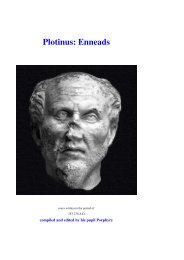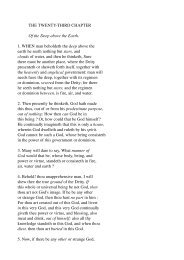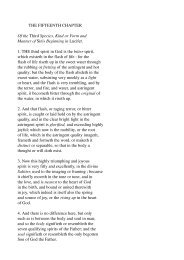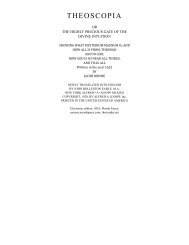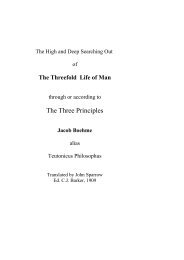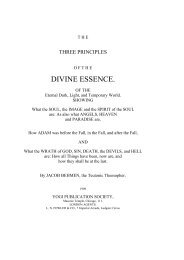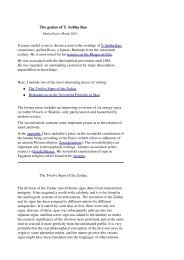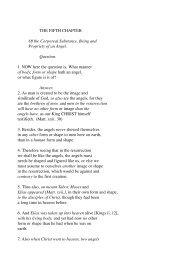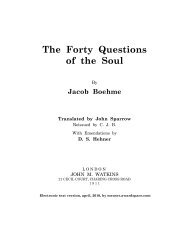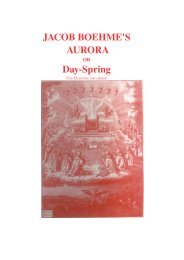Gerald Massey's Lectures - Society in evolution - Awardspace
Gerald Massey's Lectures - Society in evolution - Awardspace
Gerald Massey's Lectures - Society in evolution - Awardspace
Create successful ePaper yourself
Turn your PDF publications into a flip-book with our unique Google optimized e-Paper software.
Brothers are Sut and Osiris, Sut and Horus, the two Horuses, Taht and Aan, or Khunsu<br />
and Typhon.<br />
In his Hibbert lectures Mr. Renouf says curtly, the Egyptian god "Khunsu is the moon."<br />
But such Egyptology has not yet blazed the veriest surface of the mythology. Such<br />
statements teach noth<strong>in</strong>g truly, because they do not put <strong>in</strong> the bottom facts. They do not<br />
help us to th<strong>in</strong>k <strong>in</strong> those phenomena which have been entified or div<strong>in</strong>ised <strong>in</strong> and as<br />
mythology. It may be said quite as bluntly that Khunsu is not the moon. He only<br />
represents one phase of the lunar phenomena, which are triadic. Khunsu is the child of<br />
the sun and moon. His name denotes the young hero. When this deity was evolved it had<br />
been discovered that the moon derived her light from the sun. In the planisphere of<br />
Denderah the youthful God Khunsu is pourtrayed <strong>in</strong> the disk of the full moon at Easter,<br />
where he represents the light and force of the sun that is reborn monthly and annually of<br />
the lunar orb considered to be his mother, who thus reproduces the child of light <strong>in</strong> the<br />
disk of the moon. The same myth is likewise Osirian, as we learn from one of the hymns,<br />
where it is said, "Hail to<br />
173<br />
thee, Osiris, Lord of Eternity! When thou art <strong>in</strong> heaven thou appearest as the sun, and<br />
thou renewest thyself as the moon." But this renewal of light <strong>in</strong> the moon was pourtrayed<br />
as the re-birth of the god <strong>in</strong> the person of his own child; hence the child Horus is also<br />
depicted like the child Khunsu <strong>in</strong> the disk of the full moon, as both may be seen <strong>in</strong> the<br />
same planisphere of Denderah. Khunsu is the Egyptian Jack the giant-killer. In the Ritual<br />
he is called the slayer of rebels and piercer of the proud. His natural genesis was <strong>in</strong> the<br />
t<strong>in</strong>y light of the new moon, which rose up with its sharp horns to pierce the powers of<br />
night, and drive them out of the darkened orb. The giants of the primitive m<strong>in</strong>d were the<br />
powers of darkness, which forever rose up <strong>in</strong> revolt aga<strong>in</strong>st the light, kept all life<br />
cower<strong>in</strong>g <strong>in</strong> their shadow by night, took possession of the moon <strong>in</strong> the latter half of the<br />
lunation, or covered its face with the blood and dust of battle dur<strong>in</strong>g the terrible time of<br />
an eclipse. Then the little hero, the child of light, arose and made war on the giants, and<br />
overcame them as he grew <strong>in</strong> glory and waxed greatly <strong>in</strong> the plenitude of his Hidden<br />
father's power and might. The name of Khunsu's father is Amen, the Hidden God, the<br />
child Khunsu be<strong>in</strong>g his visible representative re-born <strong>in</strong> the new moon.<br />
Mythology is the ground-work of all our theology and Christology, and it is only by<br />
master<strong>in</strong>g the plan that we can learn how the superstructure has been built. This character<br />
of Khunsu is that of the mythical Messiah, or manifester <strong>in</strong> external nature, as a<br />
representative of the Eternal <strong>in</strong> the phenomena of time. In Egypt, Seb-Kronus, or Time,<br />
was designated the true Repa, or Heir-Apparent to the father, Osiris or Amen-Ra, and the<br />
re-birth <strong>in</strong> time, might be monthly or annually, every n<strong>in</strong>eteen or twenty-five, 500 or<br />
2155, years, accord<strong>in</strong>g to the particular period. In the mystical or spiritual phase this<br />
representative of div<strong>in</strong>ity was the Christ with<strong>in</strong>, the Son of God <strong>in</strong>carnate <strong>in</strong> matter; the<br />
Christ of the Gnostics who was not a man; their Jesus, who could not be a Jew; their<br />
Redeemer, who was but the immortal pr<strong>in</strong>ciple <strong>in</strong> man, a Deliverer from the degradation;<br />
a Saviour solely from the dissolution of matter, which the Greek poet L<strong>in</strong>us calls the<br />
"Giver of all shameful th<strong>in</strong>gs."<br />
But to return to the Moon Mythos. The legend of Samson can now be read for the first<br />
time as the Hebrew version of the Egyptian myth of Khunsu, the luni-solar hero who<br />
slays the giants--or Philist<strong>in</strong>es--and overcomes the powers of darkness. It was impossible<br />
to read the riddle by suppos<strong>in</strong>g, with Ste<strong>in</strong>thal, that Samson was simply the sun-god<br />
himself; because if he were, <strong>in</strong> kill<strong>in</strong>g the lion he would be only slay<strong>in</strong>g the reflection of<br />
himself--the lion be<strong>in</strong>g a solar type. The name of Shimshon denotes the lum<strong>in</strong>ous or<br />
sh<strong>in</strong><strong>in</strong>g one, as an emanation of the solar fire. Samson, like Khunsu, is the typical hero.<br />
Khunsu is the Egyptian Heracles. Samson, like Heracles, slays the lion, as his first great<br />
labour, or feat of strength. This deed is represented allegorically, and is put forth as his



